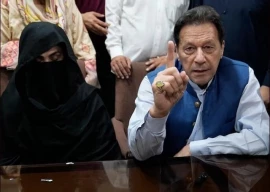
A debate on ethics and ‘moral policing’ by the media has ensued after Maya Khan’s morning show aired on SAMAA TV showed a group of women from seemingly diverging socio-economic backgrounds chasing young couples in a public park in an effort to expose their ‘immoral behaviour’.
“The media is in a state of anarchy and people have no sense of responsibility,” said Journalist Najam Sethi, who is the Editor of Friday Times and hosts a current affairs.
Despite the widespread condemnation against the show, sacking of Khan and her team and debate on media ethics, Sethi is not hopeful that there will be any regulation for live transmissions.
“The media has always resisted a regulatory body, whether it’s from the government or a self regulatory body. I have sat in many media delegations myself to persuade the government that we do not need them to regulate and that we can do it ourselves, but that never happens,” he told The Express Tribune.
“Pemra (Pakistan Electronic Media Regulatory Authority) is clearly not doing its job,” says Zohra Yusuf, Chairperson of the Human Rights Commission of Pakistan. “There is a dire need of set up an independent body to regulate the media, she says, adding that there is too much bias in reporting. “The way Husain Haqqani has been tried by the media jeopardises his chances of a fair trial.”
Journalist Beena Sarwar, who was an active member of an online campaign against the January 17 show, says media organisations need to come together and formulate regulations like they did in November 2009 when they agreed not to show dead bodies on television.
“Media owners need to adopt a code of ethics, taking on board senior producers, journalists and concerned members of society. The regulations, directives and ethics code agreed upon should then be made public so people are aware if and when they are violated,” she said.
There has also been much debate in India over regulating the electronic media. Earlier in January, Indian Prime Minister Manmohan Singh requested the media to regulate itself and find a way by which “objectivity and impartiality are encouraged and sensationalism is reduced.”
However, there are many critics of self- regulation on the other side of the border. In an article printed in The Hindu in November, the Chairman of the Press Council of India Justice Markandey Katju (a former Supreme Court judge) wrote: “Their (electronic media’s) claim is of self-regulation. But even Judges of the Supreme Court and High Courts do not have such an absolute right.”
Privacy rights
Najam Sethi believes that one of the main reasons journalists do not understand fundamental issues such as respecting people’s privacy is because of a lack of formal training. “Most senior columnists or editors have never been to a school of journalism, while younger people who study journalism are actually quite hopeless. Ethics are the last thing they are thinking of; they are not even taught the basics of reporting.”
According to Article 9 and 14 of the Constitution every individual has a right to privacy. In 1998, in the case of ‘Benazir Bhutto versus the President of Pakistan and others,’ the Supreme Court in its verdict said: “The privacy of a person cannot be intruded in public places…The inviolability of privacy is directly linked with the dignity of man.”
While advocating for citizen’s right to privacy in light of Maya Khan’s show, some journalists have acted similarly to the much-criticised actor herself. In Dawn News programme News Night with Talat on January 27, Journalist Talat Hussain showed clips of Khan dancing to highlight what he called ‘hypocrisy’.
“It’s very commendable that Talat Hussain did a show on the Maya Khan issue, but showing clips of her dancing, although they were public videos, and showing photos from a private event she was at, is quite disturbing,” said Sarwar.
Pemra’s role
On its part, Pemra says it’s doing what it can to regulate live transmissions. “We have our own monitoring system as well as a toll-free number (0800-73672) on which people can call and lodge a complaint against the electronic media. For the January 17 episode of Maya Khan’s morning show, we received 400 complaints on our number, a Pemra official said, requesting not to be named because he was not authorised to speak to the media.
“It was Pemra that made SAMAA TV render a public apology,” he claimed, adding that all television channels are required to have an editorial board and a time-delay machine to monitor content before it goes on air. “However, television channels do not adhere to these laws and do whatever it takes to keep the rating high.”
A shorter version of this article appeared in the print edition.
Published in The Express Tribune, February 3rd, 2012.
COMMENTS (4)
Comments are moderated and generally will be posted if they are on-topic and not abusive.
For more information, please see our Comments FAQ



1731655243-0/BeFunky-collage-(61)1731655243-0-165x106.webp)

1731666526-0/Express-Tribune-(9)1731666526-0-270x192.webp)
1731668520-0/Express-Tribune-(11)1731668520-0-270x192.webp)



1731656720-0/Copy-of-Untitled-(44)1731656720-0-270x192.webp)






@ Mohammad Ali Siddiqui The reason why western media have anchors/news person above 50 is because of their population pyramid, which shows that larger proportion of their population falls above 35, which is not the case in Pakistani population, where larger part is youth (above 60%). But, I agree with your view point that our media need to be matured. Regards,
One would hope that the electronic media grows out of its current immature phase soon and starts showing requisite level of responsibility in what is shown on TV.
So true, finally the issue is surfacing though. Great article.
The electronic media is Pakistan is just a crawling child and nothing more.
Look at the matured media of the Western Countries.
The anchors and hosts of the programs are normally 50+ and not the youth.
To name few, look at the anchors of BBC TV, CNN, SKY TV etc.
This is why I am saying that electronic media in Pakistan is crawling like a child.